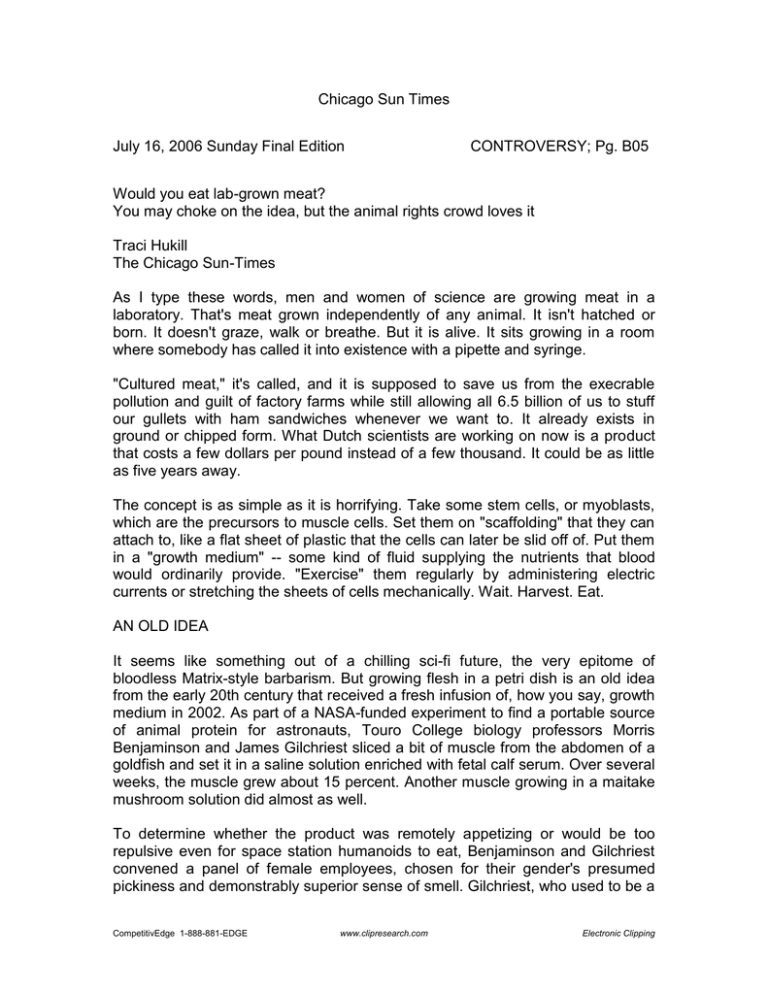Chicago Sun Times July 16, 2006 Sunday Final Edition CONTROVERSY; Pg. B05
advertisement

Chicago Sun Times July 16, 2006 Sunday Final Edition CONTROVERSY; Pg. B05 Would you eat lab-grown meat? You may choke on the idea, but the animal rights crowd loves it Traci Hukill The Chicago Sun-Times As I type these words, men and women of science are growing meat in a laboratory. That's meat grown independently of any animal. It isn't hatched or born. It doesn't graze, walk or breathe. But it is alive. It sits growing in a room where somebody has called it into existence with a pipette and syringe. "Cultured meat," it's called, and it is supposed to save us from the execrable pollution and guilt of factory farms while still allowing all 6.5 billion of us to stuff our gullets with ham sandwiches whenever we want to. It already exists in ground or chipped form. What Dutch scientists are working on now is a product that costs a few dollars per pound instead of a few thousand. It could be as little as five years away. The concept is as simple as it is horrifying. Take some stem cells, or myoblasts, which are the precursors to muscle cells. Set them on "scaffolding" that they can attach to, like a flat sheet of plastic that the cells can later be slid off of. Put them in a "growth medium" -- some kind of fluid supplying the nutrients that blood would ordinarily provide. "Exercise" them regularly by administering electric currents or stretching the sheets of cells mechanically. Wait. Harvest. Eat. AN OLD IDEA It seems like something out of a chilling sci-fi future, the very epitome of bloodless Matrix-style barbarism. But growing flesh in a petri dish is an old idea from the early 20th century that received a fresh infusion of, how you say, growth medium in 2002. As part of a NASA-funded experiment to find a portable source of animal protein for astronauts, Touro College biology professors Morris Benjaminson and James Gilchriest sliced a bit of muscle from the abdomen of a goldfish and set it in a saline solution enriched with fetal calf serum. Over several weeks, the muscle grew about 15 percent. Another muscle growing in a maitake mushroom solution did almost as well. To determine whether the product was remotely appetizing or would be too repulsive even for space station humanoids to eat, Benjaminson and Gilchriest convened a panel of female employees, chosen for their gender's presumed pickiness and demonstrably superior sense of smell. Gilchriest, who used to be a CompetitivEdge 1-888-881-EDGE www.clipresearch.com Electronic Clipping professional chef ("He makes great calamari," said Benjaminson), breaded the tiny filet and sauteed it in extra virgin olive oil. He finished with a squeeze of lemon and a dash of pecorino cheese. "And it smelled good to them," Benjaminson says. Understandably, the ladies were not asked to eat the "fish." Whatever one's response to the idea of meat grown in a petri dish -- revulsion seems to be a common one -- there are also some compelling reasons in favor of it. "It's cleaner, healthier, less polluting and more humane," said Jason Matheny, a doctoral student in agricultural policy at the University of Maryland who sits on the board of New Harvest, a research organization for in vitro meat. Meat grown in the sterile environment of a laboratory wouldn't harbor zoonotic diseases like avian flu or contribute to antibiotic resistance, Matheny said. As for human health, artery-clogging beef fat could be swapped out in vitro for salmon fat, for example, with its salubrious omega-3 fatty acids. And the squalid misery of factory farms could be bypassed altogether. No river would be fouled with manure and no chicken's beak would be clipped in the making of dinner. These are important considerations. All the problems associated with modern meat production -- like the 64 million tons of manure excreted each year by factory farmed animals in the United States alone -- are poised to worsen as the Earth's population heads toward 9 billion people by 2050. As up-and-coming nations like China and India develop large middle classes that adopt Western habits of consumption, that translates to an exponential rise in meat eaters and factory farms over the next 45 years. A SPLENDID IDEA Add it all up, and some people find cultured meat a splendid idea. Bruce Friedrich, vice president of People for the Ethical Treatment of Animals, calls it "the best thing since sliced bread." Friedrich, who energetically denounces the eating of "animal corpses" every chance he gets, says that "anything that takes the cruelty out of meat-eating is good." There are a couple of serious problems with cultured meat, though, starting with the fact that people seem to find the idea repellent. "Yeah," Matheny admits. "There's a 'yuck' factor involved with producing any novel food." Presented with the argument that cultured meat just ain't natural, Matheny gamely counters that wine and cheese are engineered products, too. CompetitivEdge 1-888-881-EDGE www.clipresearch.com Electronic Clipping "And I would say cultured meat is not inherently more unnatural than producing chicken meat from tens of thousands of animals raised intensively in their own feces and fed antibiotics," he said. That is a very good point. But then Matheny, who is vegetarian, probably won't be eating much cultured meat, either. Nor will Friedrich, who said he had done just fine without eating animal flesh for 18 years and planned to stick with his program. As for Benjaminson, when asked if he finds the idea of cultured meat appealing, he answered, "From an esthetic standpoint? No. It would have to taste palatable, and that would require a lot of tissue engineering." What a lot of trouble to go to for a solution that is frankly nightmarish (especially the "exercising" of the disembodied muscle by means of electrical shocks). All cultivation is a form of enslavement, however benevolent or necessary, but harnessing the manic energy of stem cells takes that dynamic into a realm where the side effects -- the "equal and opposite reaction" promised by Newton -- play out perilously close to the life process itself. If synthetic fertilizer, which seemed like such a great way to boost plant fertility, can create a dead zone the size of Maryland at the Mississippi Delta, wiping out a totally different link in the food chain, who's to say what would come of overexploited RNA or mitochondria? Fred Kirschenmann of Iowa State University's Leopold Center for Sustainable Agriculture just hopes there will be plenty of testing. "I'm not saying some of these new ideas can't be done and they won't work at some level, but every time we mess around with our ecological heritage there are always unintended side effects that come from it," he said. CompetitivEdge 1-888-881-EDGE www.clipresearch.com Electronic Clipping






